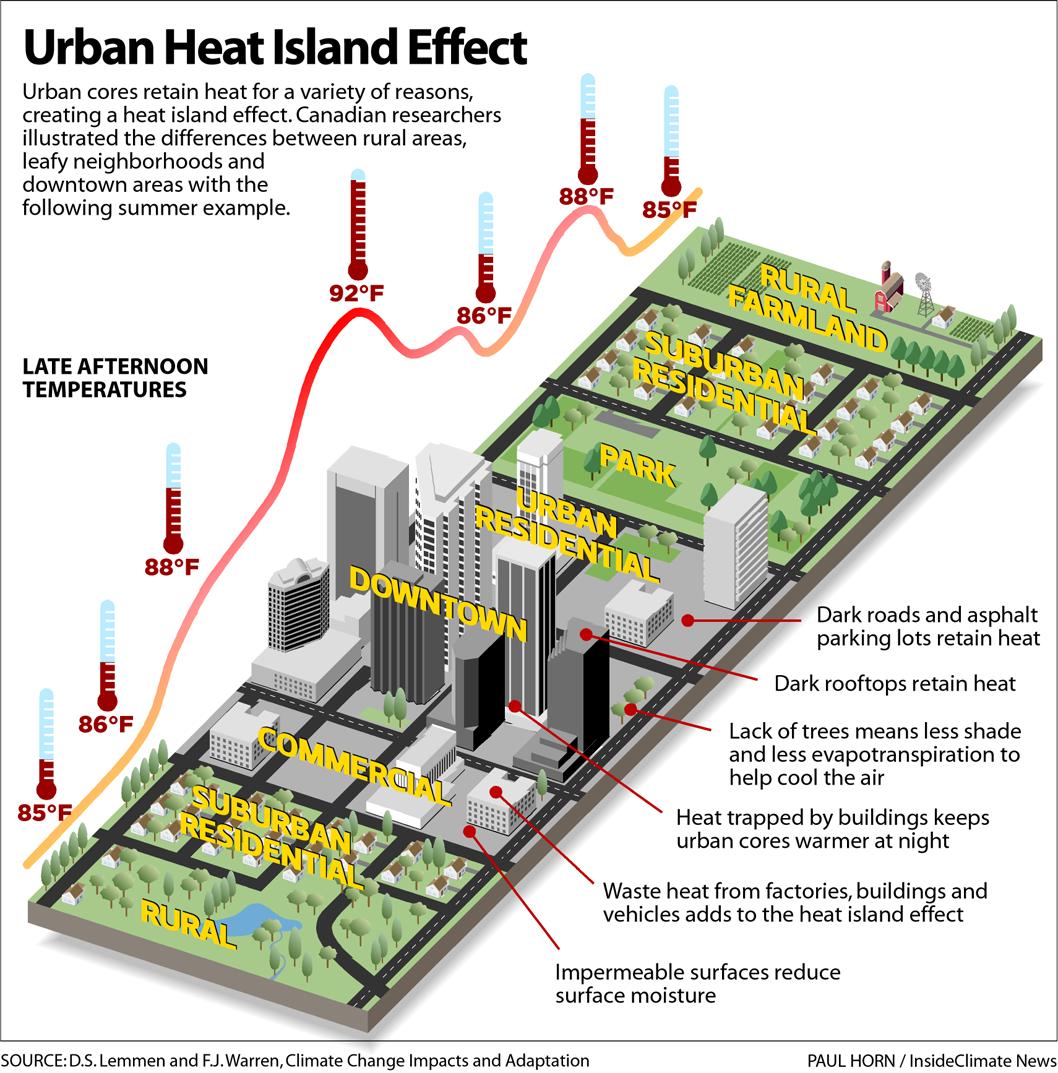Heat-baked Chennai can set an example for India
News Context
- Record-Breaking Heat in 2023: The year 2023 was recorded as the hottest ever by the World Meteorological Organization (WMO).
- Temperature Surge: Global average temperatures rose to 1.45°C above pre-industrial levels, nearing the 1.5°C limit set by the Paris Agreement.
- Growing Climate Impacts: With global emissions still on the rise, climate effects are intensifying. Scientists predict that 2024 may experience similar conditions.

The Reality of the Urban Heat Island (UHI)
- Higher Urban Temperatures: In large, densely populated urban areas, temperatures can be significantly higher than in surrounding rural regions, with nights being especially warmer.
- Heat Retention: Concrete structures and tarmac roads retain heat, which remains trapped in urban areas along with air pollutants.
- Contributing Factors: The absence of green spaces and waste heat from air conditioners and other machinery exacerbate the Urban Heat Island effect.
- Heatwave Criteria in India: In India, a heatwave is officially declared in coastal areas when maximum temperatures exceed 37°C and are 4.5°C above normal.
Heat Action Plans
- Comprehensive Plans: India has implemented national, state, and some district-level Heat Action Plans (HAP) to mitigate morbidity and mortality, particularly among vulnerable populations such as the poor, infants, and the elderly.
- NDMA Guidelines: The National Disaster Management Authority (NDMA) provides guidelines for addressing heatwaves, including early warning systems and measures such as staggered work hours and shaded areas at outdoor construction sites.
- Long-term Strategies: Beyond immediate responses to heatwaves, there is a need for long-term strategies to address the Urban Heat Island (UHI) effect and reduce urban heat.
- Chennai Climate Action Plan: The Chennai Climate Action Plan (CCAP) offers several significant recommendations for addressing heat, though these are spread across different sections.
Study and Findings
- Increasing Green Cover: Urban forests, parks, and tree-lined areas release moisture, which evaporates and cools the surroundings.
- Local Microclimate Benefits: Well-distributed green areas can influence the local micro-climate, reduce air pollution, and promote health and well-being.
- Shaded Pathways: Tree-lined walkways and tracks provide shade for pedestrians, cyclists, and itinerant workers, encouraging non-motorized transportation.
- UN Habitat Recommendations: Sustainable urban development guidelines by UN Habitat recommend that green spaces be accessible within 400 meters of all residences.
- Urban Greening Initiatives: Efforts to increase greenery in urban areas, such as the creation of “miyawaki forests,” show promise, though there are concerns about the species of trees being planted.
On the Use of Air-Conditioners and Energy Saving
- Waste Heat from Air-Conditioning: A lesser-known contributor to the Urban Heat Island (UHI) effect is the waste heat emitted by air-conditioning units.
- High Energy Consumption: In Chennai and other Indian metropolitan areas, approximately 50% of electricity consumption during summer is used for air-conditioning, which releases heat outdoors.
- Energy-Efficient Air-Conditioning: Transitioning to more energy-efficient air-conditioning systems, including mandates for purchasing five-star or split EE air-conditioners and incentives for replacing old units with new EE models, could reduce UHI by up to 1.5°C.
- Successful Examples: Cities like Shanghai and Seoul have reported significant reductions in UHI by implementing these strategies.
Way Forward
- Awareness and Savings: Increasing awareness about climate change is important, but the potential to save about 25% on electricity bills can also drive change.
- Better Building Practices: Buildings that are well-insulated, ventilated, and constructed using green building codes require less air-conditioning and produce less waste heat.
- Urban Infrastructure Improvements: Implementing permeable paving, adding shrubbery along sidewalks and dividers, and using reflective paint on roofs, walls, and streets can help reduce urban heat.
- Public Transport Over Personal Vehicles: Reducing the number of personal vehicles through the expansion of efficient public transportation, particularly electric buses, would significantly contribute to lowering urban temperatures.
Railways to construct canopy bridges across track in Assam gibbon habitat
Hoolock Gibbons and Conservation
- Railway Initiative for Conservation: The Northeast Frontier Railway (NFR) has allocated funds to build canopy bridges to help Hoolock gibbons, India’s only ape, safely cross a railway track in eastern Assam.
- Track Expansion: A 1.65-km-long railway track, which is being doubled and electrified, bisects the 2,098.62-hectare Hollongapar Gibbon Sanctuary in Jorhat district.

Hoolock Gibbons – IUCN Status: Endangered
- Significant Population: The Hollongapar Gibbon Sanctuary hosts the largest population of Hoolock gibbons, one of the 20 ape species globally.
- Habitat Preferences: Hoolock gibbons, known for their vocalizations, primarily inhabit the upper canopy of tall trees, especially the hollong (Dipterocarpus macrocarpus).
Canopy Bridges
- Forest Fragmentation Impact: The railway track has fragmented the forest, disrupting the gibbons’ arboreal lifestyle and endangering them when crossing the track.
- Bridge Design: Canopy bridges, designed by the Wildlife Institute of India (WII) in collaboration with NFR, will be placed at strategic points to aid the gibbons’ movement.
- Safety Measures: Safety nets will be installed beneath the main twin-rope bridges as a precaution to catch any gibbons that might fall.
- Natural Integration: The canopy bridges will be set up to allow lianas and creepers to grow on them, making the bridges appear as natural extensions of the forest canopy.
April core sector output rises 6.2% as electricity, steel buoy
India’s Infrastructure (Core Sector) Output in April
- Overall Growth: Infrastructure output in India rose by 6.2% year-on-year in April, up from a revised 6% growth in March, driven by strong performance in electricity and steel sectors.
- Sector Contribution: Infrastructure output, which makes up 40% of industrial production, tracks activity in eight sectors including refinery products and electricity.

Sector-Specific Performance
- Coal: Production increased by 7.5%.
- Electricity: Generation surged by 9.4%.
- Steel: Production grew by 7.1%.
- Natural Gas: Output increased by 8.6%.
- Cement: Production saw a modest rise of 0.6%.
- Crude Oil: Production went up by 1.6%.
- Refinery Products: Output grew by 3.9%, compared to a previous increase of 1.5%.
- Fertilizers: The only sector to experience a decline, with production falling by 0.8% in April.
Splash back
News Context
- Successful Test Flight: A start-up named Agnikul Cosmos successfully conducted the first test flight of its rocket ‘Agnibaan’ in a mission named ‘Suborbital Tech Demonstrator’ (SOrTeD).
- Previous Attempts: This flight was Agnikul’s fifth attempt after the first four were called off due to suboptimal launch conditions.
)
Agnibaan – An Overview
- Launch Vehicle Design: ‘Agnibaan’ is a two-stage, 14-tonne launch vehicle designed to lift small satellites to low-Earth orbits, with both stages powered by custom semi-cryogenic engines.
- Market Impact: Its success will enhance India’s commercial launch services, aligning with the growing market for small satellites and the services they provide.
- Current Roster: The current launch services market is dominated by ISRO’s Polar Satellite Launch Vehicle (PSLV) and will soon include the Small Satellite Launch Vehicle (SSLV).
Way in Advancements and Forefront
- Communication Challenge: Agnikul needs to improve the communication of its test flight parameters.
- Startups Leading Innovation: These startups are now in a position to lead and inspire ISRO and others, potentially speeding up advancements in the sector.
- Example: ISRO is testing its own semi-cryogenic engine and could benefit from the experiences and lessons learned by Agnikul.
- Technological Developments: ISRO has developed engine nozzles made from a carbon-carbon composite to replace the Columbium alloy nozzles on the PSLV’s fourth stage.
- Supportive Frameworks: The government must ensure that the bureaucratic and legal frameworks support the free exchange of knowledge.






